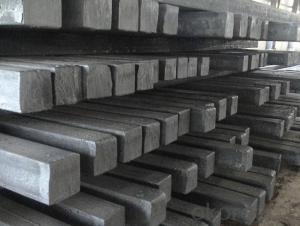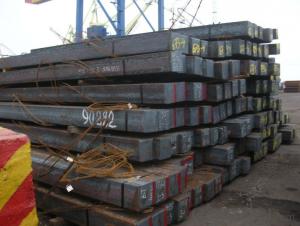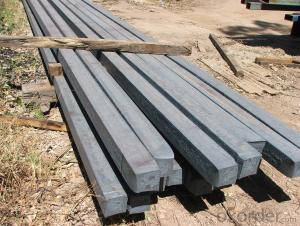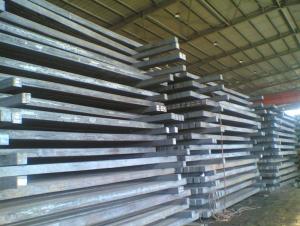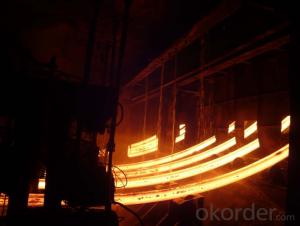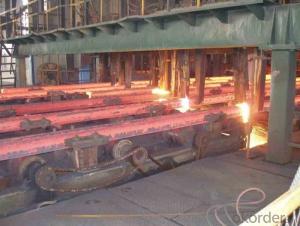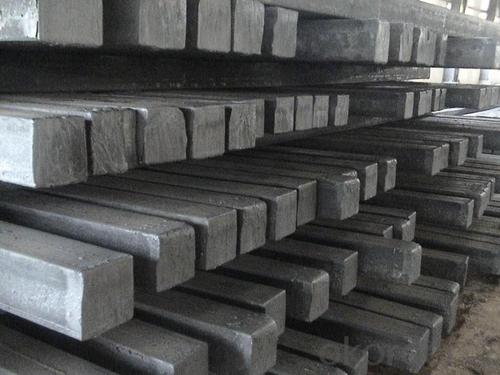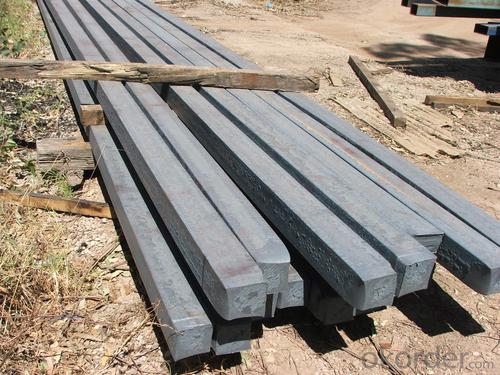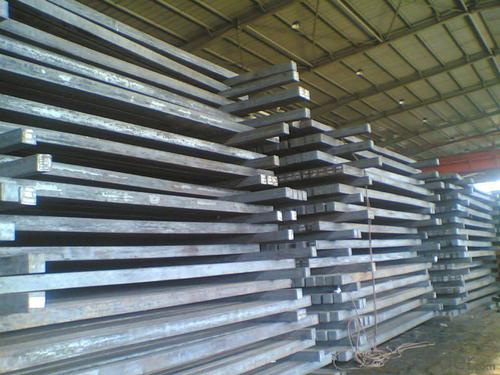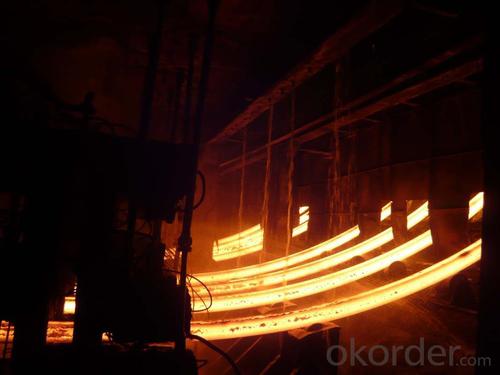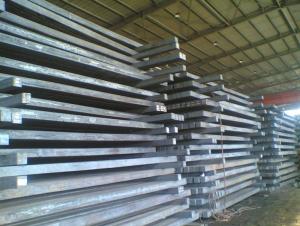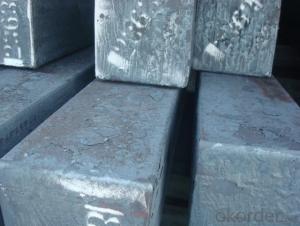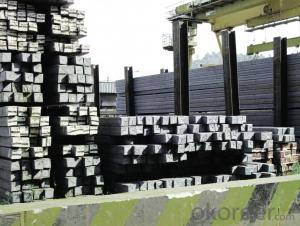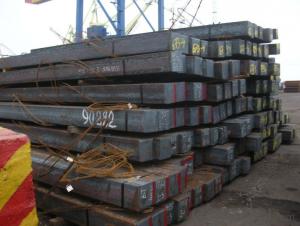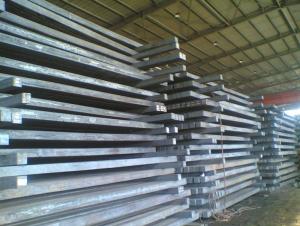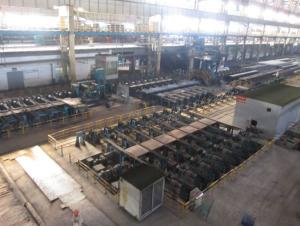Hot Rolled Square Steel Billet 3SP Standard 190mm
- Loading Port:
- Shanghai
- Payment Terms:
- TT OR LC
- Min Order Qty:
- 2000 m.t.
- Supply Capability:
- 10000 m.t./month
OKorder Service Pledge
OKorder Financial Service
You Might Also Like
Structure of Hot Rolled Square Steel Billet 3SP Standard 190mm
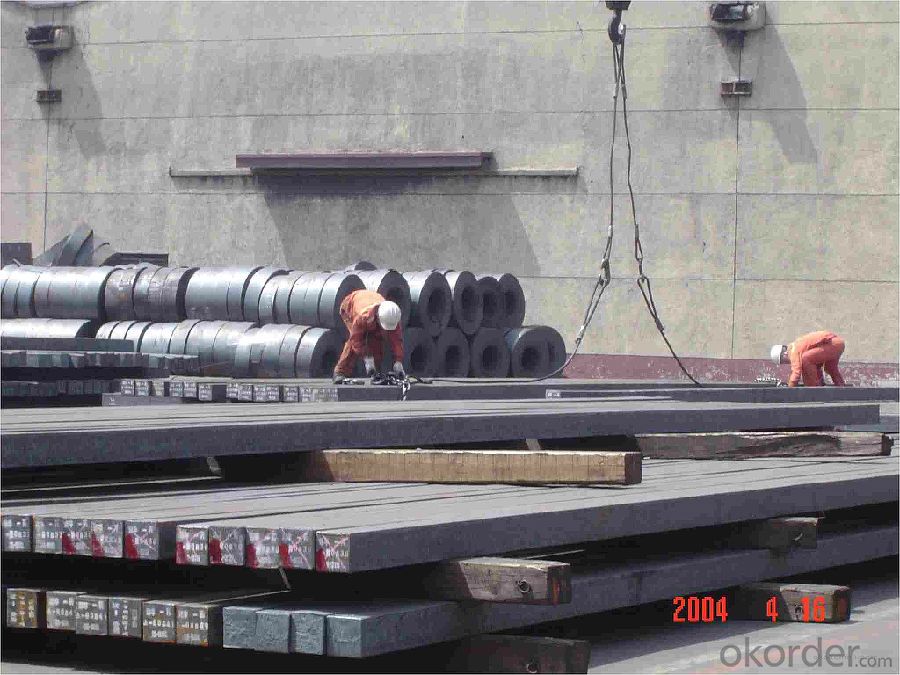
Description of Hot Rolled Square Steel Billet 3SP Standard 190mm
PPGI is made by cold rolled steel sheet and galvanized steel sheets as baseplate, through the surface pretreatment (degreasing, cleaning, chemical conversion processing), coated by the method of continuous coatings (roller coating method),
and after roasting and cooling. Zinc coating: Z60, Z80, Z100, Z120, Z180, Z275, G30, G60, G90
Alu-zinc coating: AZ60, AZ80, AZ100, AZ120, AZ180, G30, G60, G90
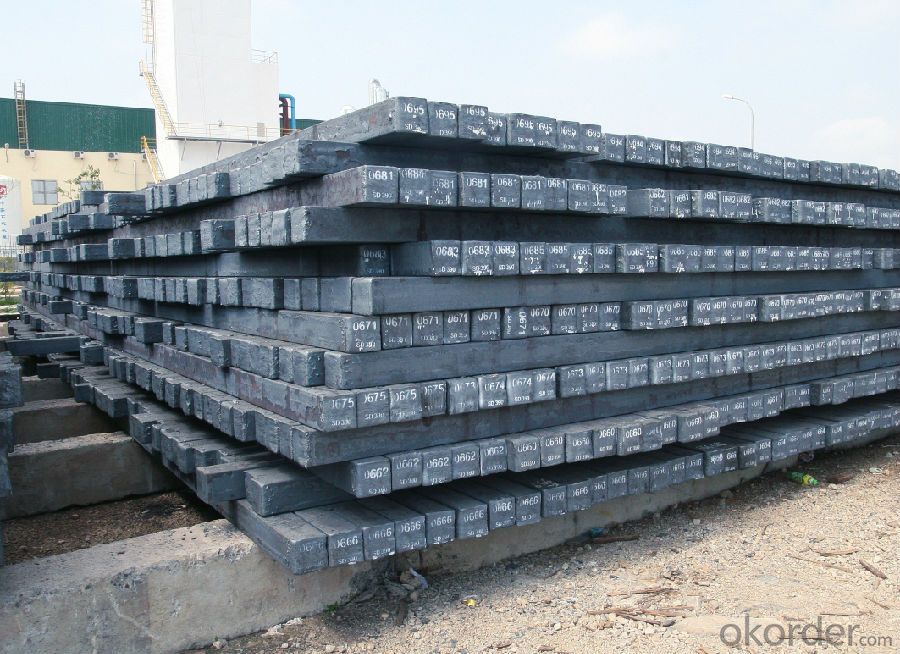
Main Feature of Hot Rolled Square Steel Billet 3SP Standard 190mm
1) Excellent corrosion resistance: The zinc layer provides a good protection of Pre-painted Galvanizeed Steel Sheet.
2) High heat resistance: The reflective surface of the material aids in efficiently reflecting the sunlight away and in turn reducing the amount of heat transmitted. The thermal reflectivity converts into energy savings.
3) Aesthetics: Pre-Painted Galvanized steel sheet is available in plethora of patterns and multiple sizes as per the requirements that given by our customers.
4) Versatility: can be used in the various areas.Standard seaworthy export packing: 3 layers of packing, inside is kraft paper, water plastic film is in the middle and outside GI steel sheet to be covered by steel strips with lock, with inner coil sleeve.
Applications of Hot Rolled Square Steel Billet 3SP Standard 190mm
1) Automotive bodies: filters, fuel tanks, etc.
2) Construction materials: roofings, welding pipes,
3) Electric and electronic appliances: computer cans, etc.
4) Steel cans: containers, etc.
5) Steel furniture: washing machines, refrigerators, microwaves, etc.
6) Drums
7) Office equipment: printer, recorders, etc.
8) Motors and transformers
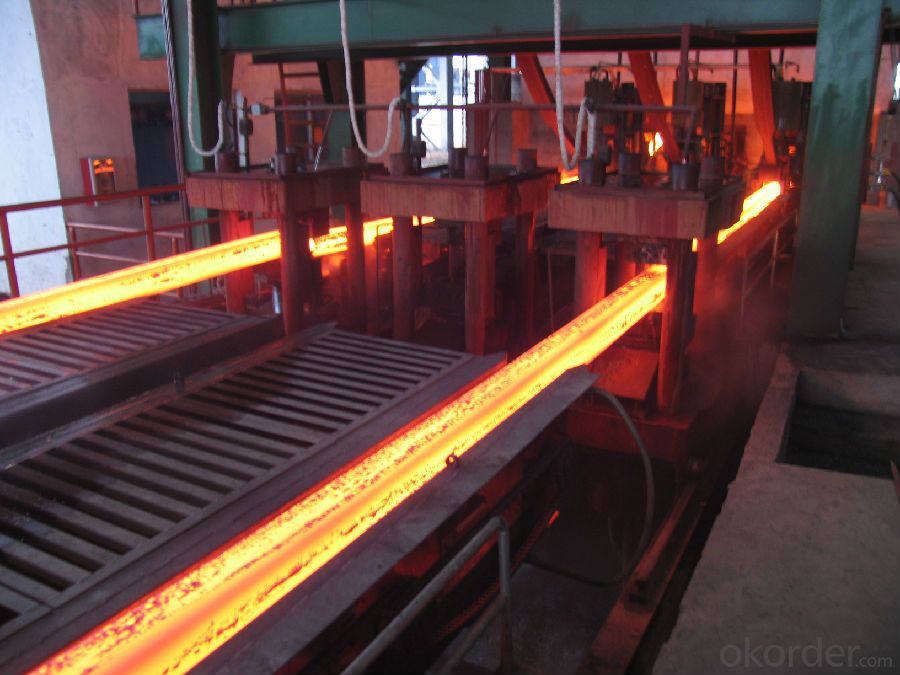
Specifications of Hot Rolled Square Steel Billet 3SP Standard 190mm
| Classified symbol | Yield Point Minimum N/mm2 | Tensile Strength Minimum | Elongation Minimum % | Application | ||||
| N/mm2 | Nominal Thickness mm (t) | |||||||
| JIS | Yogic | 0.25-0.4 | 0.4-0.6 | 0.6-1.0 | 1.0-1.6 | |||
| G3312 | specification | |||||||
| CGCC | CGCC | -205 | -270 | -20 | -21 | -24 | -24 | Commercial |
| CGCD | CGCD | --- | 270 | --- | 27 | 31 | 32 | Drawing |
| --- | CG340 | 245 | 340 | 20 | 20 | 20 | 20 | Structural |
| CGC400 | CG400 | 295 | 400 | 16 | 17 | 18 | 18 | Structural |
| CGC440 | CG440 | 335 | 440 | 14 | 15 | 16 | 18 | Structural |
| CGC490 | CG490 | 365 | 490 | 12 | 13 | 14 | 16 | Structural |
| CGC570 | CG570 | 560 | 570 | --- | --- | --- | --- | Structural |
| ASTM Designation | Yield Point Minimum | Tensile Strength Minimum | Elongation Minimum % | Application | Q/BQB 445-2004(China standard) | ASM A653/A653M | JISG 3312 | |
| ksi(MPa) | ksi(MPa) | TDC51D+Z | (CS TYPE A+Z) | CGCC | ||||
| A653(M)-99 CS TYPE A,B,C | --- | --- | --- | Commercial | TDC52D+Z | CGCD | ||
| A653(M)-99 FS | --- | --- | --- | Lock Forming | TS250GD+Z | (G250+Z) | - | |
| A653(M)-99 DS | --- | --- | --- | Drawing | TS300GS+Z | (G300+Z) | CGC 400 | |
| A653(M)-99 SS Grade33(230) | 33(230) | 45(310) | 20 | Structural | TS350GD+Z | (G350+Z) | CGC490 | |
| A653(M)-99 SS Grade37(255) | 37(255) | 52(360) | 18 | Structural | TS550GD+Z | (G550+Z) | CGC570 | |
| A653(M)-99 SS Grade40(275) | 40(275) | 55(380) | 16 | Structural | ||||
| A653(M)-99 SS Grade50(345) | 50(345) | 65(450) | 12 | Structural | ||||
| A653(M)-99 SS Grade80(550) | 80(550) | 82(570) | --- | Structural | ||||
FAQ of Hot Rolled Square Steel Billet 3SP Standard 190mm
We have organized several common questions for our clients,may help you sincerely:
1. How Can I Visit There?
Our company is located in Tianjin City, China, near Beijing. You can fly to Tianjin Airport Directly. All our clients, from home or aboard, are warmly welcome to visit us!
2. How Can I Get Some Sample?
We are honored to offer you sample.
3. Why choose CNBM?
1, ISO, BV, CE, SGS approved.
2, Competitive price and quality.
3, Efficient service team online for 24 hours.
4, Smooth production ability(50000tons/month) .
5, quick delivery and standard exporting package.
6, Flexible payment with T/T, L/C, Paypal, Kunlun bank, etc.
- Q: What are the different surface treatment options for steel billets?
- Depending on the specific requirements and applications, steel billets have several options for surface treatment. Some common methods include: 1. Pickling: Steel billets are immersed in an acid solution to eliminate scales and impurities, improving the surface finish and preparing the steel for further treatment or processing. 2. Shot blasting: Small steel shots are propelled at high velocity onto the billet surface, removing rust, scales, and contaminants to achieve a clean and smooth surface finish. 3. Phosphating: A chemical treatment involving the application of a phosphate coating onto the billet surface. This process enhances corrosion resistance, paint adhesion, and provides a uniform surface for subsequent treatments. 4. Galvanizing: A popular option where a layer of zinc is applied to the billet surface through hot-dip or electroplating. This treatment offers excellent corrosion resistance, making it suitable for outdoor use. 5. Coating: Steel billets can be coated with materials like epoxy, polyurethane, or powder coatings to enhance appearance, provide additional corrosion protection, or improve resistance to wear and tear. 6. Passivation: A chemical treatment process that removes free iron or iron oxide from the billet surface and forms a protective oxide layer. This treatment increases corrosion resistance and improves overall performance. When selecting a surface treatment method, it is crucial to consider the specific requirements and intended use of the steel billets. Factors like corrosion resistance, appearance, adhesion, and wear resistance should be taken into account to ensure desired performance and longevity.
- Q: What are the potential applications of steel billets in the agricultural sector?
- Steel billets have a wide range of potential applications in the agricultural sector. One of the primary uses of steel billets in agriculture is for the manufacturing of farm equipment and machinery. Steel billets can be used to produce durable and sturdy components such as plows, cultivators, and seeders, which are essential for tilling the soil, planting seeds, and maintaining agricultural land. Steel billets can also be utilized in the construction of storage structures on farms. Steel is known for its strength and durability, making it an ideal material for constructing grain silos, barns, and sheds. These structures provide farmers with a reliable and long-lasting solution for storing crops, livestock, and equipment. In addition, steel billets can be used to fabricate fences and gates for animal enclosures. Steel fences offer superior strength and security, ensuring the safety of farm animals and preventing them from wandering off. These fences are also resistant to corrosion and are capable of withstanding harsh weather conditions. Furthermore, steel billets can be employed in the construction of irrigation systems and water management infrastructure on farms. Steel pipes and fittings are commonly used to transport water from a source to the fields, ensuring proper irrigation and efficient water distribution. Lastly, steel billets can be utilized in the production of machinery used for processing agricultural products. For example, steel components can be used to manufacture grain mills, threshers, and sorting machines, which aid in the processing and packaging of crops. Overall, the potential applications of steel billets in the agricultural sector are vast and varied. From farm equipment and storage structures to fencing and irrigation systems, steel billets play a crucial role in enhancing efficiency, durability, and productivity in agriculture.
- Q: What are the different packaging options available for steel billets?
- Steel billets can be packaged in various ways to meet the specific needs and preferences of customers. Here are some commonly used packaging options: 1. Wooden Crates: To ensure safe transportation and storage, steel billets can be secured in sturdy wooden crates. These crates offer protection against moisture and physical damage. 2. Steel Frames: Another option is to package the steel billets using steel frames. These frames, made of strong and durable steel bars, securely hold the billets in place, providing stability and protection. 3. Plastic Wrapping: Plastic wrapping is also a viable packaging method. It involves tightly wrapping the billets with plastic film to shield them from dust, moisture, and scratches. 4. Wire Binding: Steel billets can be bundled together using steel wires, a common packaging choice. This method ensures stability and prevents movement during transportation. 5. Customized Packaging: Some customers may require customized packaging for their steel billets. This can involve using specific materials like foam or cardboard for added protection, or incorporating branding elements on the packaging. Ultimately, the choice of packaging depends on factors such as billet size and weight, mode of transportation, and specific customer requirements. It is crucial to consider factors such as protection, stability, ease of handling, and cost-effectiveness when selecting the most suitable packaging option for steel billets.
- Q: How do steel billets contribute to the manufacturing of HVAC systems?
- Steel billets play a crucial role in the manufacturing of HVAC (Heating, Ventilation, and Air Conditioning) systems. These systems require robust and durable components to ensure efficient operation and longevity, and steel billets provide the necessary foundation for such components. Firstly, steel billets are used to create the main structural framework of HVAC systems. The framework, often referred to as the casing or housing, provides support and protection for the internal components, such as the heat exchangers, fans, and coils. Steel billets offer high strength and rigidity, making them ideal for creating a sturdy and reliable framework that can withstand the various stresses and strains encountered during the system's operation. Moreover, steel billets are also used to manufacture various internal components of HVAC systems. For example, the heat exchangers, which are responsible for transferring heat between the air and the refrigerant, are commonly made from steel billets. The high thermal conductivity and corrosion resistance of steel make it an excellent choice for these critical components, ensuring efficient heat transfer and long-term performance. Additionally, steel billets are utilized in the production of ductwork. Ductwork is the network of pipes or channels that distribute conditioned air throughout a building. Steel billets are often rolled and formed into the required shapes to create the ducts. The strength and durability of steel ensure that the ductwork can withstand the pressure differentials and mechanical stresses associated with air movement, maintaining the integrity of the system and preventing leaks. Furthermore, steel billets are essential for manufacturing HVAC system supports and brackets. These components are used to mount various equipment, such as air handling units or condensing units, securely. Steel's strength and load-bearing capacity make it an ideal material for ensuring the stability and proper installation of these crucial elements. In conclusion, steel billets are integral to the manufacturing of HVAC systems. They provide the necessary strength, durability, and thermal properties required for the structural framework, internal components, ductwork, and supports. Without steel billets, it would be challenging to produce HVAC systems that deliver efficient heating, ventilation, and air conditioning to buildings.
- Q: What are the potential applications of steel billets in the food and beverage industry?
- The food and beverage industry has a wide range of potential applications for steel billets. One of the primary uses is in producing stainless steel equipment, such as tanks, vessels, and processing machinery. Due to its corrosion resistance, durability, and hygienic properties, stainless steel is the preferred material in this industry. Steel billets are commonly utilized in the manufacturing of stainless steel pipes and fittings, which are essential components in food and beverage processing plants. These pipes and fittings are responsible for safely and reliably transporting fluids, gases, and food products. Additionally, steel billets can be used to create stainless steel bar and rod, which find various applications in kitchen equipment, cutlery, and utensils. Stainless steel bar and rod are ideal for food preparation and serving as they are highly resistant to staining, rusting, and chemical corrosion. Moreover, steel billets can be employed in the production of stainless steel sheets and plates, which are used for food storage and packaging. Stainless steel sheets and plates offer a durable and hygienic surface for food storage containers, countertops, and shelving units. They are easy to clean, resistant to bacterial growth, and do not react with acidic or alkaline food products. Overall, steel billets play a vital role in the food and beverage industry by providing the necessary raw material for manufacturing stainless steel equipment, pipes, fittings, bar, rod, sheets, and plates. The use of stainless steel enhances food safety, ensures product integrity, and contributes to the efficient and hygienic operation of food and beverage processing facilities.
- Q: Are steel billets recyclable?
- Yes, steel billets are recyclable. Steel is one of the most recycled materials in the world, and the process of recycling steel billets is well-established and highly efficient. When steel billets reach the end of their useful life, they can be melted down and reused to produce new steel products. This recycling process helps to conserve natural resources, reduce energy consumption, and minimize environmental impact. Additionally, recycling steel billets also helps to reduce the amount of waste sent to landfills and contributes to the circular economy by promoting the sustainable use of resources.
- Q: How are steel billets used in the production of industrial valves?
- Steel billets are used in the production of industrial valves as they serve as the raw material for shaping and forming various valve components, such as bodies, bonnets, stems, and discs. Through machining, forging, and welding processes, the steel billets are transformed into the required shapes and sizes, ensuring the strength and durability of the valves.
- Q: How do steel billets contribute to the manufacturing of sports equipment?
- Steel billets contribute to the manufacturing of sports equipment in various ways. Firstly, steel billets are the raw material used to produce steel bars and rods, which are then used to create the frame and structure of sports equipment such as golf clubs, tennis rackets, and hockey sticks. The strength and durability of steel make it an ideal material for these applications, as it can withstand the high impact forces and stresses that occur during sports activities. Additionally, steel billets are also used to manufacture components of sports equipment such as weights, dumbbells, and barbells. These components require a high density material that can handle heavy loads, and steel provides the necessary strength and stability. Furthermore, steel billets are used in the production of sports equipment accessories like ball bearings, springs, and fasteners. These small yet crucial components play a vital role in the overall performance and functionality of sports equipment. Steel's excellent corrosion resistance and ability to withstand extreme conditions make it a preferred choice, ensuring long-lasting and reliable performance. Moreover, steel billets contribute to the manufacturing of sports equipment by enabling the production of high-quality and precision-made parts. Steel's malleability and formability allow it to be shaped into various complex designs and configurations, ensuring that sports equipment meets the specific requirements of athletes and performs optimally. In summary, steel billets are an indispensable component in the manufacturing of sports equipment. Their strength, durability, versatility, and formability make them an ideal material for producing frames, components, and accessories that enhance the performance and longevity of sports equipment.
- Q: How are steel billets used in the manufacturing of electrical transmission equipment?
- Steel billets are used in the manufacturing of electrical transmission equipment as a key raw material. These billets are essentially solid blocks of steel that undergo further processing to transform them into various components required for electrical transmission equipment. One of the main uses of steel billets in this context is for the production of transmission towers. These towers provide the infrastructure needed to support power lines and ensure the safe and efficient transmission of electricity over long distances. Steel billets are used to manufacture the structural components of these towers, including the main vertical and horizontal members, as well as the cross arms and braces. Additionally, steel billets are also used in the manufacturing of conductors for electrical transmission equipment. Conductors are the cables that carry the electrical current between power generation stations and distribution networks. Steel billets are processed to create the necessary wires and strands that are then used to construct these conductors. The high strength and durability of steel make it an ideal material choice for these applications, as it can withstand the high tension and load requirements of electrical transmission systems. Furthermore, steel billets are used in the production of various other components used in electrical transmission equipment, such as pole line hardware, insulators, and connectors. These components are crucial for the proper functioning and reliability of the electrical transmission system, and steel billets provide the necessary strength and stability required for their construction. In summary, steel billets play a vital role in the manufacturing of electrical transmission equipment. They are used to produce transmission towers, conductors, and other essential components, ensuring the safe and efficient transmission of electricity across long distances.
- Q: What are the different types of steel billet defect detection methods?
- There are several different types of steel billet defect detection methods that are commonly used in the industry. These methods help identify any defects or imperfections present in the steel billets, ensuring that only high-quality products are being produced. Some of the different types of steel billet defect detection methods include: 1. Visual Inspection: This is the most basic and common method, where trained inspectors visually examine the billets for any visible defects such as cracks, surface irregularities, or deformations. While effective for detecting certain types of defects, this method may not be able to identify internal or hidden defects. 2. Ultrasonic Testing: This method uses high-frequency sound waves to detect defects within the billets. Ultrasonic waves are passed through the billet, and any irregularities or disruptions in the waves indicate the presence of defects such as cracks or voids. Ultrasonic testing is a widely used technique for detecting internal defects. 3. Magnetic Particle Inspection: This method involves magnetizing the steel billet and then applying iron particles. If there are any surface or near-surface defects, the particles will be attracted to these areas, making the defects visible. Magnetic particle inspection is particularly effective for detecting surface cracks and discontinuities. 4. Eddy Current Testing: This technique uses electromagnetic induction to detect surface or near-surface defects in steel billets. A coil carrying an alternating current is placed near the billet, and any changes in the electrical conductivity or magnetic properties of the material caused by defects are detected. Eddy current testing is particularly useful for detecting surface cracks and corrosion. 5. X-ray Testing: X-ray inspection involves passing X-ray radiation through the steel billet and capturing the resulting image on a film or digital detector. Any internal defects such as cracks, voids, or inclusions will show up as dark spots on the X-ray image. X-ray testing is highly effective for detecting internal defects. 6. Laser Scanning: This method uses a laser scanner to create a three-dimensional image of the steel billet's surface. Any irregularities or deformations in the surface can be detected and analyzed using specialized software. Laser scanning is a precise and efficient method for detecting surface defects. These are just a few of the different types of steel billet defect detection methods that are commonly used in the industry. Each method has its own advantages and limitations, and the choice of method depends on factors such as the type of defect being targeted, the size and shape of the billets, and the level of precision required. By employing these defect detection methods, manufacturers can ensure the production of high-quality steel products.
Send your message to us
Hot Rolled Square Steel Billet 3SP Standard 190mm
- Loading Port:
- Shanghai
- Payment Terms:
- TT OR LC
- Min Order Qty:
- 2000 m.t.
- Supply Capability:
- 10000 m.t./month
OKorder Service Pledge
OKorder Financial Service
Similar products
Hot products
Hot Searches
Related keywords
